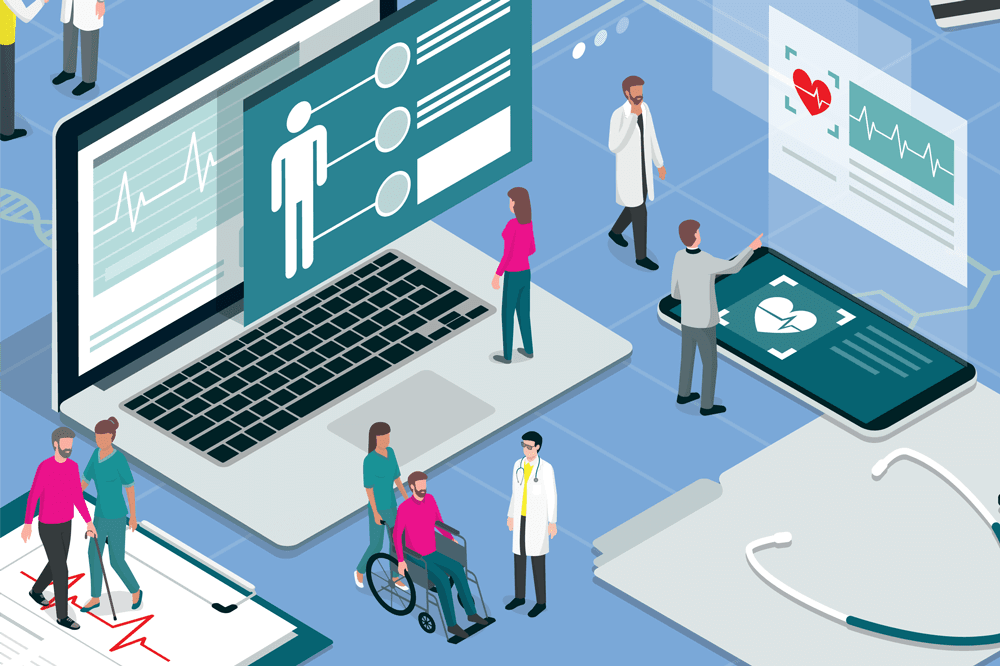At a Glance
Although we don’t often refer to ourselves as clinicians, we are, at our core, a clinical discipline
Students entering the medical profession must know where the laboratory is located and what it does
An orientation that walks students through pathology and laboratory medicine can help them understand our function
Such an orientation may even increase overall interest in pathology as a career
Most pathologists and laboratorians refer to patient-facing providers as “clinicians,” and to the information garnered from the interactions these healthcare workers enjoy as the proverbial “clinical correlation.” What do we mean by this? Is it because we reserve this term for only those healthcare providers who run their practice from an actual clinic? Does that mean that the information coming from our microscopes and our laboratories is not clinical? And, if that is the case, what is it? Research?
This issue came to the frontlines a few years ago, when we found out that the incoming third-year (M3) medical students at our institution have an introduction to the “clinical’ aspects of the hospital in a two-week long orientation at the beginning of the academic year. Meticulously designed and laboriously executed, when we saw the details of this orientation, it seemed a practically superhuman feat to put such an event together for hundreds of students.
But despite its comprehensive nature regarding most components of clinical medicine, it missed one big thing: the entire world of pathology and laboratory medicine. Every aspect of this orientation conveniently skirted around the labs. The students were introduced to each step in the process of ordering labs in a patient’s electronic medical record; in fact, they even learned how to “call and complain” to the lab – but, despite this long orientation process, our discipline itself remained a black box to them. In fact, until a few years ago, we’re fairly certain that medical students could spend their entire time on our health sciences campus, see patients, order and retrieve hundreds – if not thousands – of lab tests, get their degrees, and leave… all without even knowing where the lab was actually located!
The problem… and our solution
So why was this the case? A quick review showed us that it was obviously not malicious intent on the part of the orientation’s coordinator. It was probably a complex issue with several layers, but we believe that the simplest explanation is as follows: our specialty isn’t thought of as clinical medicine. Our patient-facing colleagues don’t think so – and, each time we say “clinical correlation is recommended,” we help perpetuate that thought. We are truly out of sight and out of mind, a “black box” that spits out patient results. This happens in part because we let it happen. And so, my colleagues and I decided to change that.
In April 2017, at the beginning of their orientation to the clinical aspects of the hospital, the third-year medical students on our health science campus were introduced for the first time to the pathology laboratories! The proposal we made to the Director of the M3 curriculum was met with enthusiasm and positivity, and we were given precious time out of a tightly packed schedule to split the entire M3 class into two groups and deliver each group an identical orientation to the mysteries of the clinical laboratory.
In hindsight, the start of M3 was the ideal point in the four-year US medical school system for such an introduction. Students have already completed their combined medicine–pathology course in M2 and, as a result, many of them feel that their brief foray into pathology is over. To them, our specialty is just “Robbins” or “Pathoma” or something that needs to be put into short-term memory for their USMLE Step 1 exams. Lack of a required clerkship in pathology further supports this misconception. What we set out to do in the “M3 orientation to the pathology labs” was clarify that pathology and laboratory medicine are at the heart of all medicine. No matter which rotation students may be on in their third and fourth years of medical education, they are concurrently (effectively) on a longitudinal pathology clerkship as well.

Building an orientation
This project demanded attention to detail, as well as careful coordination between the medical school, the hospital administration, the educational directors, and even the fire marshal! The pressure was on. We could not risk the project’s turning out to be a bust, because that would have been devastating to the field of pathology. And because time was so precious, every minute had to be worth it; we couldn’t give the students the sense that their time had been wasted. We had to relay a sense of the importance of pathology and, at the same time, convey that we – and our discipline – are fun. Now that is a tall order.
We decided to make the process mirror reality. To represent how “clinical” we truly are, the entire project revolved around a patient case. Our only condition was that the students come to us in the labs. This was on purpose. For every other orientation session, students were expected to go to the relevant department in the hospital – and we knew that, if we didn’t encourage them to come down to the basement now, it would never happen. That doesn’t mean it was easy. Even split in half, each orientation group was between 70 and 90 students, and attendance was required by the clerkship director. Fitting so many additional people into our department was tricky, but we made it!
The day started off with a working breakfast and a 25-minute presentation of our case. A middle-aged gentleman presents with a cough. Eventually a mass is found in the lung. The session guided the students through intraoperative analysis (frozen section), permanent section and FFPE processing, immunohistochemical staining, FISH and molecular studies, and personalized diagnostics in anatomic pathology. After that portion of the event was complete, the cohort was split into four groups and escorted by residents to one of four stations in the clinical pathology labs.
Those of you who work in smaller laboratory spaces are most likely already cringing – after all, groups of 20 or more students entering and making their way through the lab would certainly cause delays and interruptions. That was true of our department as well, so laboratory directors or their representatives for hematology, the blood bank, core lab/chemistry, and microbiology were waiting outside their labs to greet the students. We placed large posters in the hallways at all four stations to demonstrate how our patient passed through them.
In the course of his postoperative care, he required routine monitoring discussed at the core lab/chemistry station; he needed a CBC (which showed lymphocytosis and needed flow cytometry) that was discussed at the hematology station; he developed fevers and sepsis discussed at the microbiology station; and, finally, an unforeseen complication led to the need for a blood transfusion and a possible transfusion reaction that was dealt with in immunohematology/at the blood bank. We created 10–12-minute talks at each station and the students rotated through all four sessions before being dismissed from the orientation. The entire process, from start to finish, was around 2 hours per group.

Is it working?
The M3 orientation to the labs was a labor of love, and yes – it has been successfully implemented every year since with great feedback! Now entering its third year, the event is an opportunity to showcase the importance of the laboratory, remind medical students of our role as consultants and diagnosticians, and to make sure that, if nothing else, they know the importance (and the location!) of the pathology laboratories.
We use it as an opportunity to advertise the field, emphasize proper laboratory test utilization, and promote programs such as Choosing Wisely. The students leave with the understanding that, even if they choose not to become pathologists, their future careers are intimately related to the information coming from the lab. Their granular understanding of how things function “in the basement” remains essential for our mutual provision of the best and most cost-effective patient care.
As educators, we find the questions and intrigue our students display at these sessions uplifting. We have also seen an increase in the number of elective requests in pathology over the past few years – and, when asked, many of the students credit their attendance at our orientation session as one of their reasons for thinking of us. The aim of the pathology elective, and of the M3 orientation to the labs, is not to coerce medical students into becoming pathologists, but to instill an understanding of the role pathology and laboratory medicine play in patient care. At the same time, these things stand as a reminder to us all that pathology is, at its heart, a clinical specialty.




